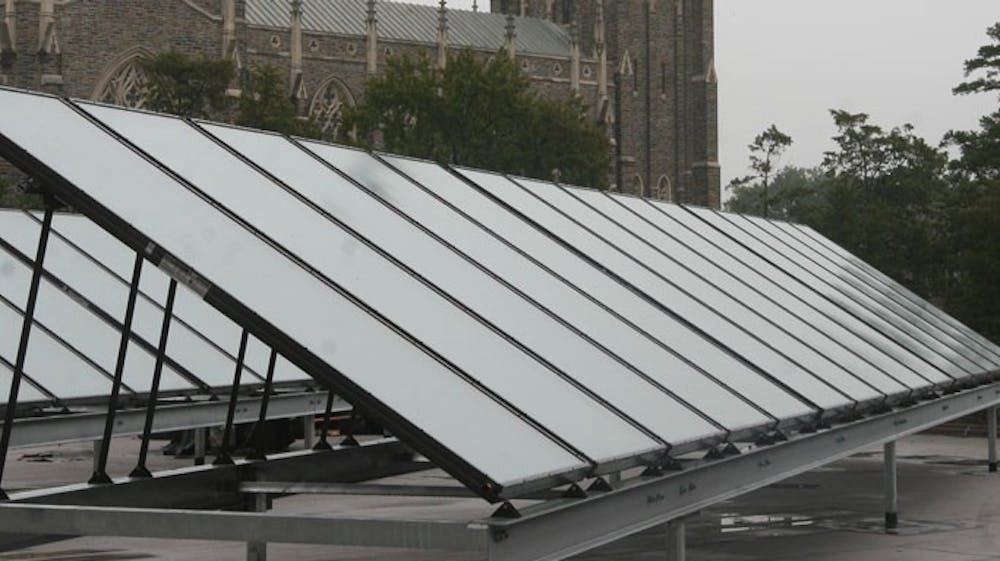Solar panels atop the Bryan Center are putting Durham sunshine to good use.
The Raleigh-based renewable energy company Holocene has installed 45 solar thermal panels on the roof of the Bryan Center. The project, which is overseen by Duke Facilities Management, began Sept. 15 and is slated to be functional by the end of the month, Facilities Management Energy Manager Steve Palumbo said. The goal of the solar panels is to harness the sun’s rays to heat water for the Bryan Center. The project is part of Duke’s climate action plan adopted by the Board of Trustees in 2009.
“Now we’re using basically sunlight, which has no carbon emissions, to heat water which would otherwise be heated using some sort of fuel,” Palumbo said.
The solar thermal collectors will heat 30 to 40 percent of the building’s hot water, Palumbo said. The panels will absorb heat from the sun and transfer it into water, which is pumped through the panelss’ pipes into a 2,000-gallon holding tank. The water then travels through the tanks in a separately enclosed heat exchange system, picking up heat from the tank until it is hot enough to be piped into the sinks of the rest rooms and restaurants of the Bryan Center. The domestic water—used in restrooms’ sinks and restaurants—is currently heated by steam from the campus steam plants, which burn natural gas.
The 4 feet by 10 feet panels sit on the roof over Reynolds Industries Theater in three rows atop galvanized steel frames. The panels are fixed pointing south at a roughly 36-degree angle to better catch the sun, Project Manager Myron Taschuk said, noting that the optimal angle varies depending on latitude.
Each panel consists of a translucent blue-green pane of textured glass, which encloses several rows of flat plate collectors. The collectors consist of corrugated copper layers that sandwich the water pipes. Copper acts as a particularly effective heat transmitter, Taschuk added.
“People always say that a parked car traps heat inside of it, right?” Taschuk said. “These are parked cars that have tubes inside to circulate water and remove that heat.”
Facilities Management chose the Bryan Center for the solar panel project because of its relatively constant hot water usage, in part due to its high concentration of eateries, Palumbo said. Depending on how the panels perform, the University may install them elsewhere as well.
“We’re installing it, we’re learning about it,” he said. “Then we would analyze the results and look at other facilities on campus to see if there’s a match. But first we want to understand how it functions there.”
Duke bore no cost for the capital expense of the project, Palumbo said, adding that Duke’s only financial commitment is to purchase the solar thermally heated water from Holocene. Energy companies like Holocene are incentivized to install solar panels at institutions such as Duke in order to take advantage of state and federal tax credits. As a nonprofit, Duke is unable to take advantage of reductions in taxes from renewable energy incentives, Palumbo said. The cost of the project has not been disclosed.
Holocene Director of Sales Charles McClure said tax incentives help the renewable energy industry grow to a sustainable level.
“Right now incentives at the state and federal level for this industry are absolutely essential,” McClure said. “To create a viable industry... it has to make it through a growth period. It needs a few years to grow and become strong.”
Under the current arrangement, Holocene will own and operate the installation for seven years to fully process the tax incentives and will sell Duke the hot water at prices comparable to the market rate for hot water from conventional energy sources, McClure said. After seven years, the solar panels will revert back to Duke’s ownership and the University will benefit from not having to pay an outside source for hot water.
The next phase of construction will include the installation of copper pipes to connect the thermal collectors to the holding tank and the addition of the tank itself, Taschuk said. He estimated that the project is on schedule to finish by the end of October.
Get The Chronicle straight to your inbox
Signup for our weekly newsletter. Cancel at any time.

